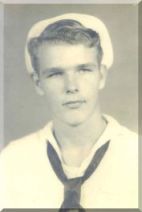Vets' decline adds urgency to memorial
WWII site 'a little to late' for many, says American Legion Official from Indiana.
April 30th, 2004
by James A. Gillaspy
The Indianapolis Star
WASHINGTON --
John Brockmann is standing in the rain, talking about the war. The big one. WWII.
He's in the right place for it, just steps from the nation's new National World War II Memorial and its archway salute to campaigns in the Pacific theater.
"I tell you, it's beautiful," said Brockmann, an old salt who waged war aboard a Navy cruiser when he and many of his gunnery shipmates were just 17.
Sixty-one years later, his presence here, despite his Parkinson's disease, explains the rush to remove perimeter fencing and open the memorial before next month's dedication. That happened Thursday. But it was a few days late for Brockmann, who hoped to take a closer look during his visit Monday.
With more than a thousand World War II veterans dying each day, monument officials don't want aging survivors to have to wait for the May 29 dedication.
Hugh Dagley understands the sentiment. As adjutant of the Indiana department of the American Legion, he's had a hard time mustering support for a veterans trip to dedication festivities that begin here May 27 and run through Memorial Day weekend.
"We had originally anticipated a much larger subscription," said Dagley, who has planned a bus excursion from Indianapolis that will include an all-expense-paid trip for a WWII vet from each of Indiana's 11 Legion districts.
The expected legions of other veterans and veterans' families never surfaced.
"We didn't get really the number of people I thought we would get, and we've seen, unfortunately, a pretty high rate of cancellation as folks get sick or as they decide that they just can't make it.
"I think this memorial probably came a little too late for a lot of folks. It's kind of sad, because they anticipated it for a lot of years."
More than 16 million U.S. armed forces personnel served in World War II from Dec. 1, 1941, to Dec. 31, 1946, and 292,000 of them died in battle, according to the Census Bureau. Today, there are about 4 million still living.
The effort to create the first national memorial to all WWII veterans -- as well as those who supported the war effort at home -- began in earnest with congressional approval in 1993 that precipitated years of fund raising and deliberation. Work began in September 2001.
With just spit-and-polish preparations remaining, the site on the National Mall already is a destination point for tourists, student field trips and the occasional fading veteran.
On the rainy occasion of Brockmann's appearance, he and his wife of 49 years, Tommie, have come from Raleigh, N.C., and taken time out from their history tours with three grandchildren for some private time here.
At 78, about the youngest age possible for any WWII vet who enlisted without fibbing about his birthday, Brockmann is oblivious to the pelting rain as his mind slowly tracks to 1943 and a three-hour battle aboard the USS Salt Lake City that helped turn the tide in the Aleutian campaign.
"We had the longest sea battle in the history of World War II," Brockmann said of the engagement with a Japanese convoy in the Bering Sea.
The U.S. task force patrolling off the Komandorski Islands was outnumbered but not outmatched by determined enemy warships escorting vital supply ships.
In the ensuing bombardments, the Salt Lake City inflicted and sustained serious damage. Enemy shelling killed two men and threatened to sink the ship as she lay dead in the water.
With the crew under fire, the threat of sinking grew larger. The captain considered the ship's fate.
Brockmann said the captain belayed an order to abandon ship after the ship's doctor said cold water would kill the men in minutes.
"He turned and said to tell the admiral we will not abandon ship -- we will go down with the ship," said Brockmann.
Moments later, the danger was over.
The effect of the attacks by the Salt Lake City and the smaller destroyers in the task force put the enemy on the run. Japanese reinforcements and supplies never made shore.
"It was a good victory for us," said Brockmann, whose ship made it to port for repairs.
The Navy became an adventure the young seaman pursued for 20 years, finally retiring as a chief petty officer.
But it didn't end there. He still attends annual reunions of surviving crew members, still wears the cap proclaiming his service aboard the ship that was later put down and reborn as a submarine, and still reveres the memory of those who served.
The national memorial, he said, is a fitting reminder.
Return to Battle of the Komandorski Island Index
|


 John Edward Brockmann passed away on Oct. 22nd, 2008. Information from surviving spouse, Tommie.
See Obituary Below
John Edward Brockmann passed away on Oct. 22nd, 2008. Information from surviving spouse, Tommie.
See Obituary Below